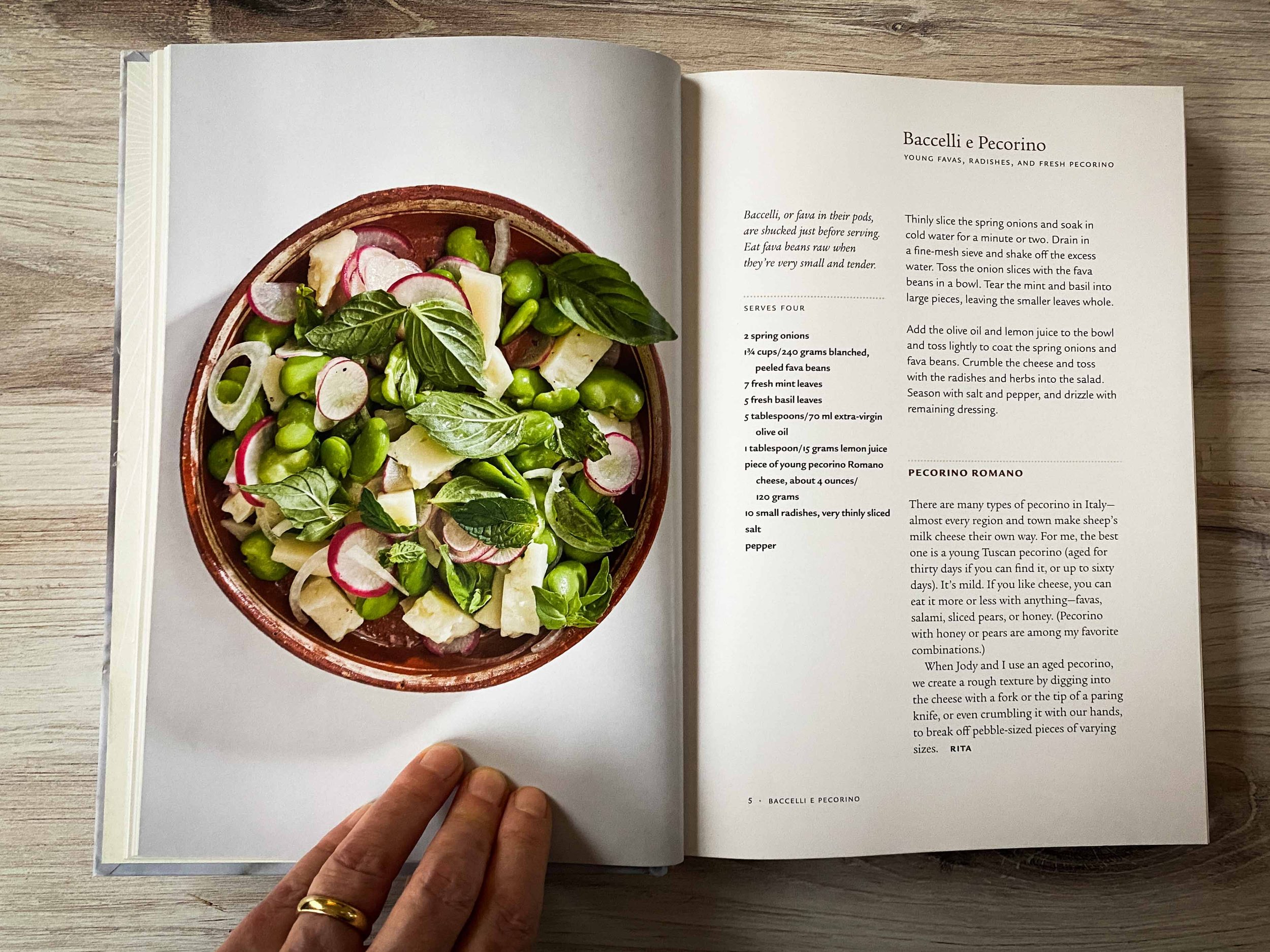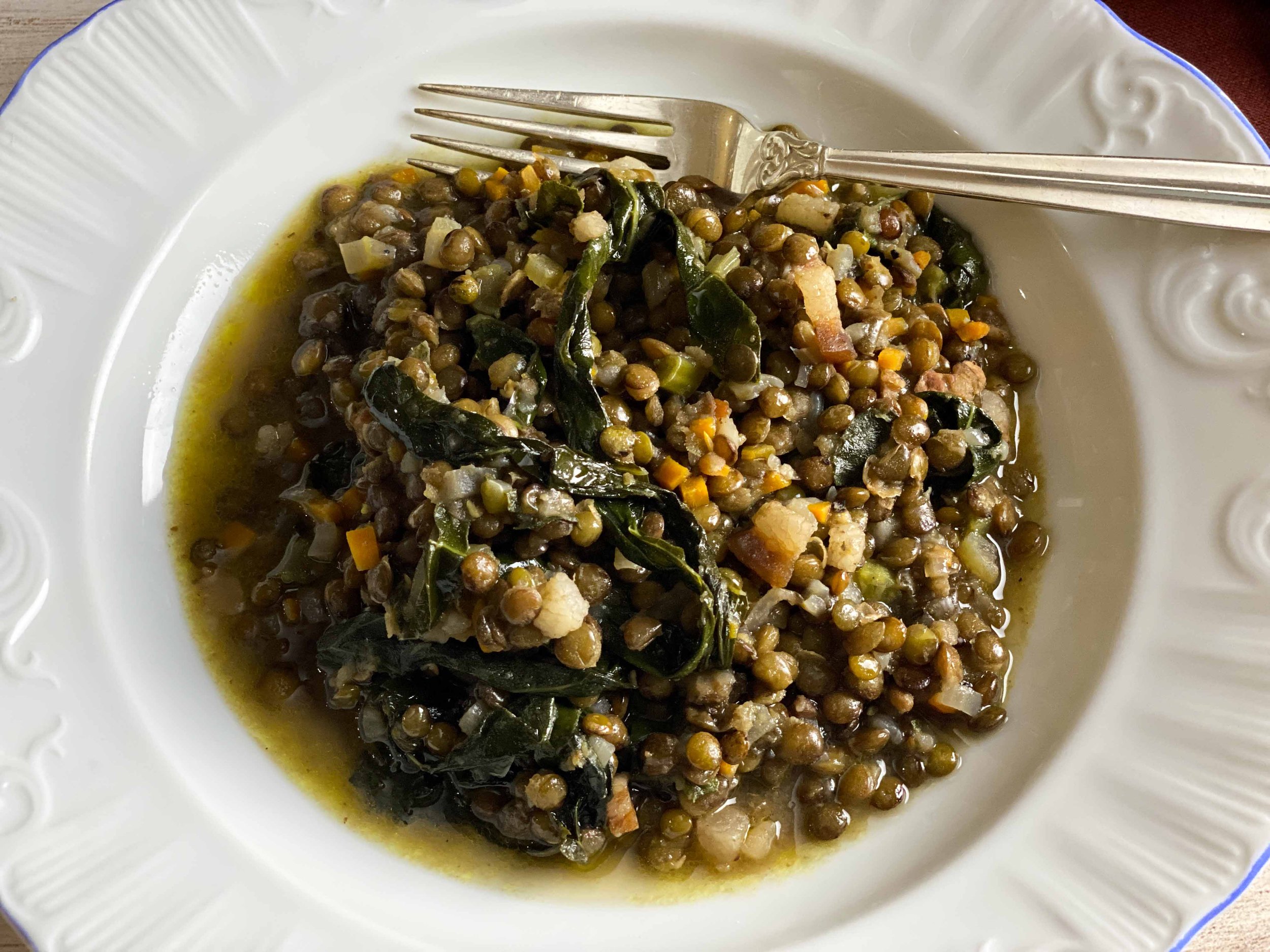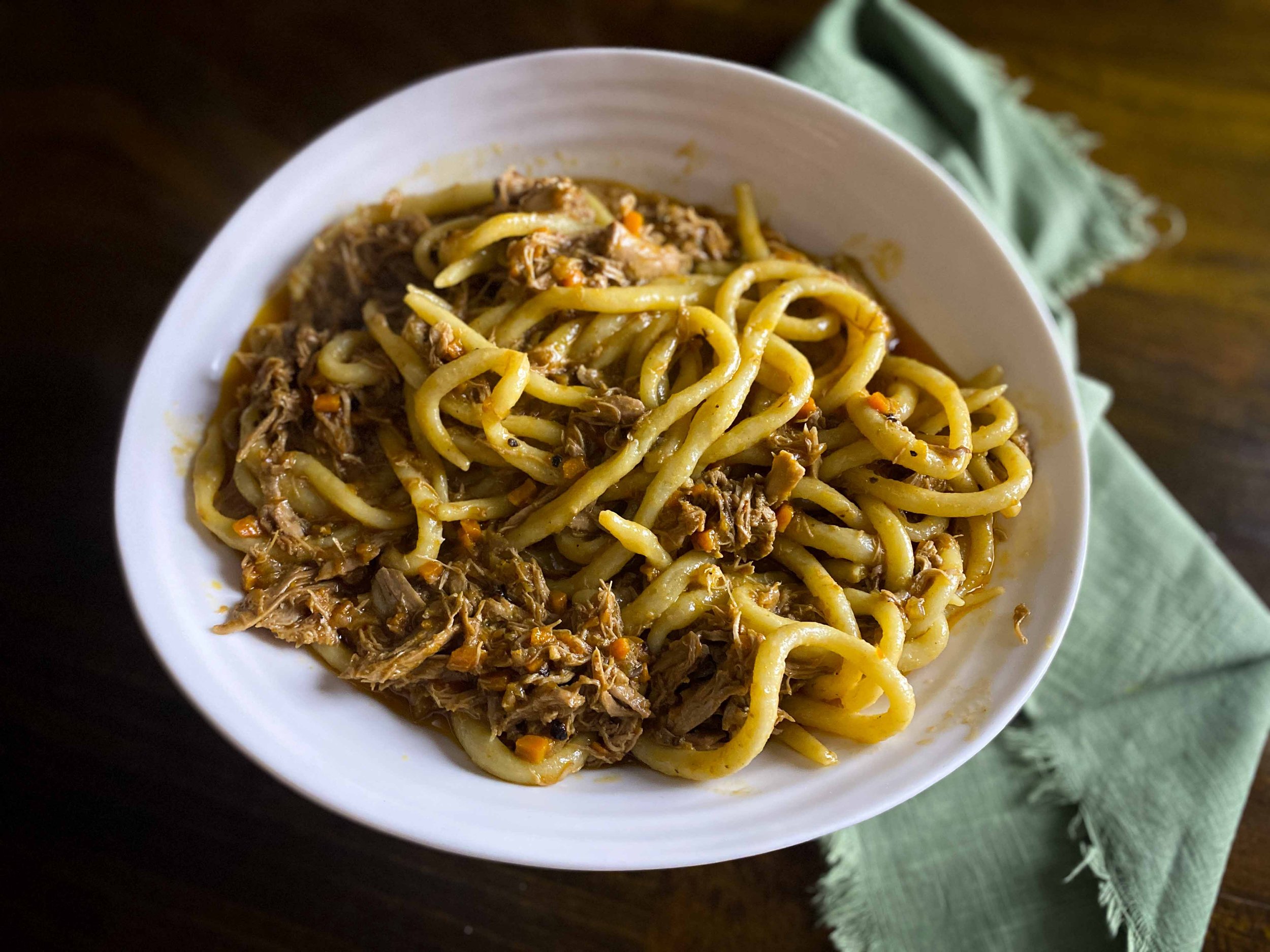By Leslie Brenner
Via Carota: A Celebration of Seasonal Cooking from the Beloved Greenwich Village Restaurant, by Jody Williams and Rita Sodi with Anna Kovel, photographs by Gently & Hyers, Alfred A. Knopf, $40.
For those of us who love to devour new cookbooks, it has been a truly outstanding year. Exciting titles published this fall include Masa, Budmo! and Kolkata, and we have reviews of many more exceptional volumes planned for the coming weeks.
Now, after poring through dozens of titles over the course of the year and cooking from loads of them, a clear favorite has emerged: Via Carota: A Celebration of Seasonal Cooking from the Beloved Greenwich Village Restaurant.
If you’re not familiar with Via Carota, it’s the New York City restaurant Jody Miller and Rita Sodi opened in 2014 — the one the New Yorker called, four years later, “New York’s most perfect restaurant.” People who don’t live in New York, or who don’t follow such things but love to cook, might know Via Carota by its famous green salad — you know, the one The New York Times Magazine called “The Best Green Salad in the World.”
Yep, there’s just something magical and irresistible about the place, its food and its vibe — hence the generous side order of superlatives.
Yet Via Carota is anything but snazzy or flashy; in other words, not the type of place that would seem to inspire hyperbole. It’s laid-back, casual and quietly delicious — self-assured in its seasonal, produce-driven, understated way.
We’ll need to wait till spring to try the first recipe in ‘Via Carota’: Bacelli e Pecorino.
That appealing aesthetic is expressed brilliantly in Miller and Sodi’s book (the partners are co-chefs and co-owners). Flip through its pages and it is impossible not to get drawn in by its lovely images and glorious-sounding dishes. They’re beautifully photographed (by Gentl & Hyers), but as much as anything, it’s their simplicity and harmony that make it all so enticing.
It’s all right there in the first recipe: Baccelli e Pecorino — Young Favas, Radishes, and Fresh Pecorino. The lead-off for the “Spring” chapter, it’s an effortless toss of sliced spring onions, fresh favas, basil, mint, radish slices and crumbled pecorino Romano, dressed with lemon juice and olive oil. Think you don’t need a recipe for that? Maybe you don’t. But Williams and Sodi’s attention to detail and proportions are what make these simple dishes great, so I’ll follow it to the letter the first time I make it, come spring.
The book has a way of making you slow down and take pleasure in the process of creating beautiful, delicious food. Sodi grew up near Florence, in Barberino di Mugello, and Williams learned to cook working at a celebrated cafe in Emilia-Romagna. They met in the West Village, where Sodi had her restaurant I Sodi, and Williams had a French place, Buvette; they loved spending time together at Sodi’s home in a restored 17th-century stone villa on Via del Carota. They both were so busy running their respective New York restaurants (and Williams had just opened a second Buvette, in Paris) that they had less time to spend in Italy, Sodi sold the villa, and they leased a space on Grove Street to open something together, not knowing what it would be.
“We did not know what to expect of our collaboration,” writes Sodi in the introduction. “We had no name or specific plans — we only had our time in Italy. We knew we wanted to recreate our experience there, the place we loved most with the food we relished most. If we were lucky, it could be a place full of life where people would feel welcome and nourished.”
Of course it became Via Carota. And of course the famous Insalata Verde — which nearly every table orders — is in the book, along with advice about “taking good care of your leaves,” and permission to eat the salad with your hands.
Via Carota’s pages are jammed with enticing recipes. Stracci — big, floppy squares of handmade pasta dressed in a Pesto di Fave (fava pesto). Garlic Scapes with Lima Beans. Braised Lamb Shoulder with Lemon Zest, green olives and capers. Lasagna Cacio e Pepe. Smashed Figs with Sesame and Honey, which also has a little aged balsamic vinegar. Here’s all there is to that one: “Slice the figs in half or tear them with your hands. Arrange them on plates and smash the interiors lightly with a fork. Drizzle with honey and balsamic vinegar. Lightly toast the sesame seeds in a dry skillet over medium heat, shaking the pan until they’re aromatic, about 2 minutes. Sprinkle the seeds over the figs.” How inspiring is that?
After plastering the book with Post-its marking my need-to-makes, I dove in and made one just right for the current season: Insalata di Cavoletti — Brussels Sprouts Salad with Walnuts and Apples.
Williams and Sodi have you massage the Brussels sprouts leaves with Via Carota Vinagrette (secret ingredient: water). Then add apple matchsticks, toasted walnuts, crumbled aged cheese and orange zest, and toss again. Let the salad “settle” for 10 minutes (how nice to have one that doesn’t have to get right to the table!), then top with more apple matchsticks and pomegranate seeds. Sure, it’s a bit time-consuming removing the leaves from the Brussels Sprouts, but the salad is so good, I’ll do it again a hundred times.
RECIPE: Via Carota Insalata di Cavoletti (Brussels Sprouts Salad)
Laced throughout Via Carota are interesting side notes about ingredients, scenes from the authors’ Italian days and nuggets of kitchen wisdom. For instance, I never quite know how to handle spring onions (not scallions, but the ones with the enlarged white bulbs). Williams and Sodi have you soak slices of them in water for a minute or two, to take away their edge — same thing they do with minced shallot, in their vinaigrette. (Water is an important ingredient at Via Carota — a couple teaspoons of it balance the vinaigrette.) A quick two-paragraph footnote offers a career’s-worth of actionable info about the joys of pecorino cheese, followed by the best thing I’ve ever read about how to choose, cook and peel favas. Later, we’re advised to collect Pecorino Romano or parmigiano rinds and make stock with them — which we can use to make a peppery besciamella (bechamel) with the flavors of cacio e pepe.
This book will make just about anyone a better cook; it’s the opposite of the kind of chef books that blithely assume we home cooks have access to 9,000 special ingredients and a walk-in full of advance preps.
Heartwarming in Cold Weather
Lenticchie con Cavolo Nero — Braised Lentils and Kale — is about as demanding as it gets in that regard. It calls for either black Umbrian or French green lentils, Tuscan kale (also known as lacinato or dinosaur kale) and either pancetta or guanciale, plus onion, carrot, garlic and sage. It’s a breeze to put together, and soul-satisfying this time of year. It’s in the “Autumn” chapter, but I’ll be making it all through the winter. I just bought a hunk of pancetta, sliced it and froze it; I always keep lentils and aromatics on hand, so kale will be the only necessary purchase whenever I want to simmer up a pot.
Naturally I had to try one of the handmade pastas in the book, so I went for a shape I’d never made: pici, which are hand-rolled thick spaghetti. Made from semolina and 00 flour, with no eggs, pici are traditional in the Tuscan province of Siena, where they’re commonly served with ragù of duck or boar, or with mushrooms.
The pasta dough came together easily, and Williams and Sodi’s instructions for rolling them with your fingers and palms into long, uneven snakes (like Play-Doh!) were simple to follow. In fact I was surprised at how easy they were to achieve, and it didn’t take as long as I’d expected. Making them was delightfully contemplative. It invited taking pleasure in the process; it would also be a lot of fun to do with kids of just about any age.
And they were insanely good, with fabulous texture. Delicious with the extremely rich duck ragù.
Pici — Hand-Rolled Thick Spaghetti — ready to be cooked. They’re meant to be imperfect.
RECIPE: Via Carota Pici all’Anatra (Hand-Rolled Spaghetti with Duck Ragù)
A few wee glitches
Wonderful as it is — and I highly recommend buying a copy not just for yourself, but for every Italophile cook on your holiday list — the perfect restaurant’s cookbook isn’t perfect. There was too much ragù, for instance, for the 14 ounces of pici the pasta recipe yields. (We adjusted, so our adapted recipe makes more pasta — perfect for the amount of sauce.) And a recipe for a gorgeous Crosta di Mandorle — Almond Tart — has you roll out a 10-inch circle of dough that is not large enough to go up the 1-inch sides of the 9-inch tart pan it calls for. I rolled it out as thin as I could, but it fell apart, and I wound up pressing it into the pan, without a millimeter to spare. I baked it till the almonds were golden-brown, as instructed, but the filling wasn’t quite cooked through — which I didn’t learn till I served it.
But the wee glitches were far outnumber by the wild successes — like this Torta al Cioccolata, which might well be the best flourless chocolate cake I’ve ever made. It’s puffed when it comes out of the oven, and then it collapses (it’s supposed to), and the top forms a kind of crackly crust that contrasts wonderfully with the soft interior.
For people who love to spend time playing with gorgeous produce, communing with pasta dough or meditatively simmering, Via Carota is a true gift — one that’s sure to inspire endless pleasurable time in kitchen and at table. As my grandma — who taught me to bake and to love literature — used to tell me, I envy you the pleasure of reading it for the first time.
We’re excited to dub it Cooks Without Borders’ first-ever Cookbook of the Year.
Find more cookbook reviews from Cooks Without Borders
If you enjoyed this story, you might like:
“‘Masa’ is a must-have cookbook for Mexican cooking aficionados and aspirants'“
“Cookbooks We Love: ‘Budmo!’ deliciously captures the spirit of Ukraine”
“Cookbooks We Love: The flavors of India’s cultural capital shine in ‘Kolkata’”
“Cookbooks We Love: Hooni Kim’s ‘My Korea’ is a knockout of a Korean cooking primer”







